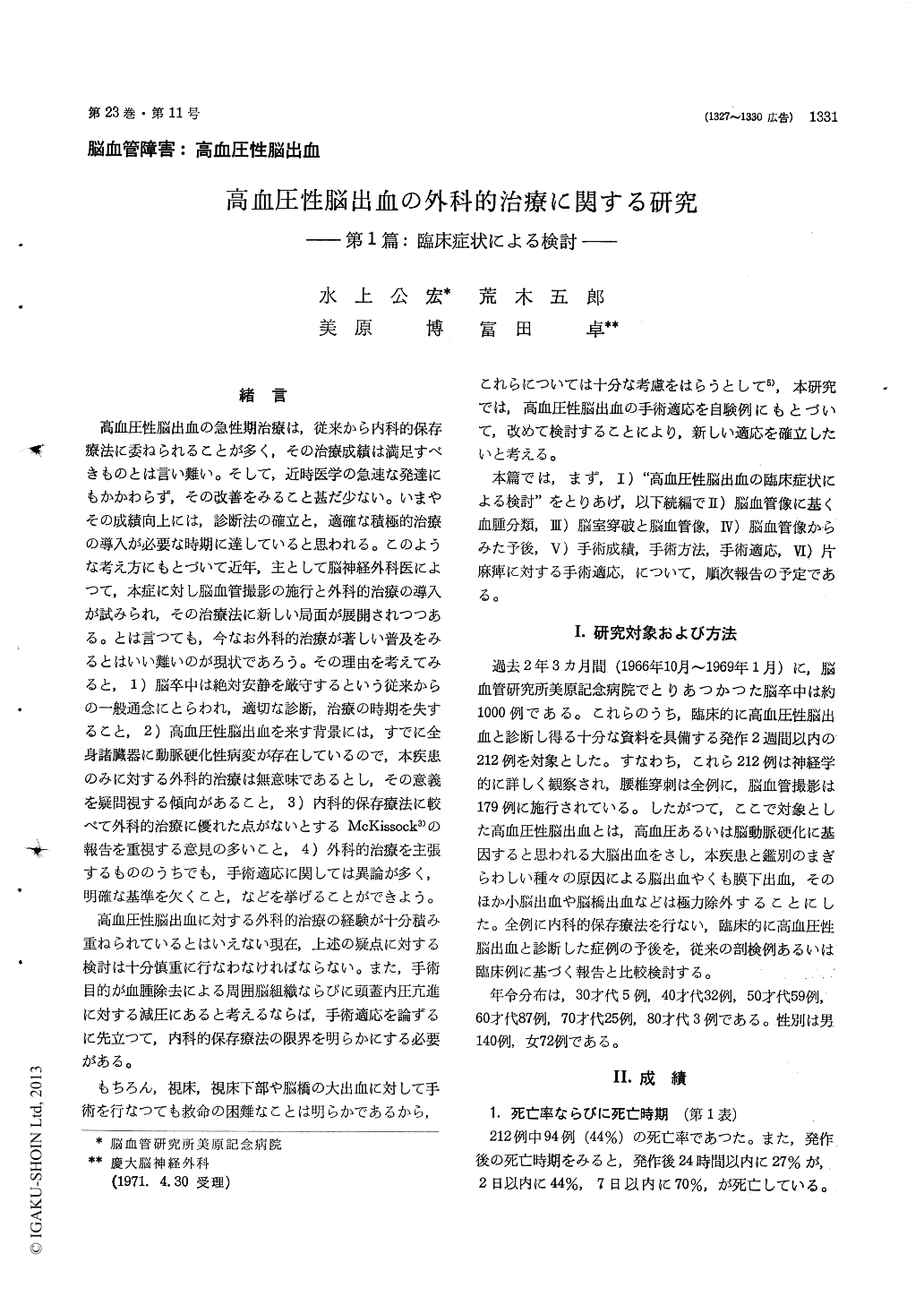Japanese
English
- 有料閲覧
- Abstract 文献概要
- 1ページ目 Look Inside
緒言
高血圧性脳出血の急性期治療は,従来から内科的保存療法に委ねられることが多く,その治療成績は満足すべきものとは言い難い。そして,近時医学の急速な発達にもかかわらず,その改善をみること甚だ少ない。いまやその成績向上には,診断法の確立と,適確な積極的治療の導入が必要な時期に達していると思われる。このような考え方にもとづいて近年,主として脳神経外科医によつて,本症に対し脳血管撮影の施行と外科的治療の導入が試みられ,その治療法に新しい局面が展開されつつある。とは言つても,今なお外科的治療が著しい普及をみるとはいい難いのが現状であろう。その理由を考えてみると,1)脳卒中は絶対安静を厳守するという従来からの一般通念にとらわれ,適切な診断,治療の時期を失すること,2)高血圧性脳出血を来す背景には,すでに全身諸臓器に動脈硬化性病変が存在しているので,本疾患のみに対する外科的治療は無意味であるとし,その意義を疑問視する傾向があること,3)内科的保存療法に較べて外科的治療に優れた点がないとするMcKissock3)の報告を重視する意見の多いこと,4)外科的治療を主張するもののうちでも,手術適応に関しては異論が多く,明確な基準を欠くこと,などを挙げることができよう。
高血圧性脳出血に対する外科的治療の経験が十分積み重ねられているとはいえない現在,上述の疑点に対する検討は十分慎重に行なわなければならない。また,手術目的が血腫除去による周囲脳組織ならびに頭蓋内圧亢進に対する減圧にあると考えるならば,手術適応を論ずるに先立つて,内科的保存療法の限界を明らかにする必要がある。
Conflicting opinions exist concerning the surgical treatment of hypertensive intracerebral hemorrhage. Yet many reports have emphasized the poor out-look offered by conservative management.
With the hope that surgical treatment might be an effective measure in such fatal cases, we have been trying to find reliable operative criteria.
Our study is begin to know the prognosis of hypertensive intracerebral hemorrhage treated con-servatively and to assess the prognostic factors derived from careful observation of 212 consecutive cases. All these cases were diagnosed by clinical symptoms, lumbar puncture, cerebral angiography and/or autopsy.
1. The overall mortality was 44% and 27% of them died within 24 hours and 70% was within 7 days after onset.
2. Mortality rate progressively increase with deepening level of consciousness. Death rate of deep comatose and semicomatose patients is 94% and 64% respectively. On the contrary all the patients who were alert at admission survived.
3. The conscious level is, however, decided upon at a fixed moment in time of admission, so it de-mands consideratiod in evaluation of intervals be-tween onset and admission.
When our partients are regrouped according to their conscious state at the 2 days of admission, death rate of the patients who are semicoma and deep coma within 2 days after onset increase up to 83%.
The urgent operation may offer a chance of recovery in these patients if the initial attack is not overwhelming.
4. Early appearance of papilledema within 48 hours have considerable significance for the pro-gnosis, the mortarity rate being 72%.
We can, therefore, estimate the speed of the hematoma spread by close observation of the pro-gression of conscious level and appearance of papilledema.
5. It is important that the site, size and growing speed of the hematoma be determined preoperatively for the successful surgery. Moreover the emergency surgery must be performed before secondary brain stem compression occurs.

Copyright © 1971, Igaku-Shoin Ltd. All rights reserved.


